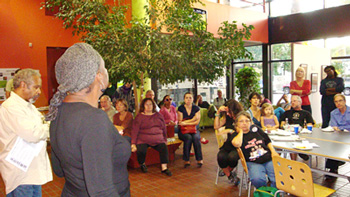

Vol. 77/No. 34 September 30, 2013

|
| Franklin Curbelo |
| Opening of watercolors exhibit by Antonio Guerrero, one of Cuban Five, in Minneapolis Sept. 12. “I Will Die the Way I Lived,” works include 15 pieces for 15 years of incarceration. |
“I’m convinced they were framed,” said Tamiko Saunders, a home health care worker and one of 70 people at the event, many of whom like herself were new to the case of the Five. “The exhibit is wonderful, there is lots to read. I just wish there were more pieces.”
“Looking at Antonio’s pieces reminded me of the beauty that can come from an ugly space, deep expressions in shallow surroundings,” said Brooke Dillard-Saunders, a young worker who has been part of protests against the police killing of Terrance Franklin here. “It had an us versus them effect for me.”
In an introductory note Guerrero says, “All these images have one thing in common: they were memories of the unjust and cruel treatment given to us since the very first day of our detention.”
Guerrero further writes, “They portray moments of our days of survival, isolated in the punishment cells of the ‘hole’ of the Federal Detention Center of Miami for 17 months. After finishing painting number 15, I made the decision to stop in this number, because it coincides with the number of years that soon will mark our captivity.” Some of the paintings also help capture the resilience and fighting spirit of the Five.
“They not only take away your freedom, but they turn you into a number,” Guerrero writes in a description of “Number,” the second piece in the series. “The Letter P” and “Fishing” show how prisoners communicated by spelling out words through a small glass window and used hooks and string to exchange messages and other items. “The Vent” illustrates how during a period in which some of the Five were in adjoining cells they were able to communicate through air vents. “The Chains” depict the shackles used whenever they were taken out of the “hole.”
After initially being kept apart, the Five eventually won their fight to share cells and later to join the general prison population.
Three of the paintings depict games — chess, Parcheesi and cubilete, a dice game — fabricated with materials at hand and secretly played to pass time.
Rose Brewer, a professor of African American and African Studies at the University of Minnesota, and Mel Reeves, a longtime campaigner against police brutality in the city, spoke during a brief program.
“We are glad to announce that two Minnesota unions — AFSCME Local 3800 and UFCW Local 1189 — have added their voices to the list of organizations in support of releasing the Cuban Five,” reported August Nimtz, speaking for the Minnesota Cuba Committee, an event sponsor along with the Minnesota Immigrant Rights Action Committee. A prominent article in Insight News, a local Afro-American newspaper, helped attract people to the event.
Fifteen copies of The Cuban Five: Who They Are, Why They Were Framed, Why They Should be Free were sold at the event.
Those interested in organizing an exhibition can contact the International Committee for the Freedom of the Cuban 5 at info@thecuban5.org.
Related articles:
Build int’l fight to free the Cuban 5!
Protests, meetings mark 15 years since arrest of Cuban Five
Who are the Cuban 5?
Nelson Mandela: Cuba’s aid to Africa is unparalleled
Front page (for this issue) |
Home |
Text-version home